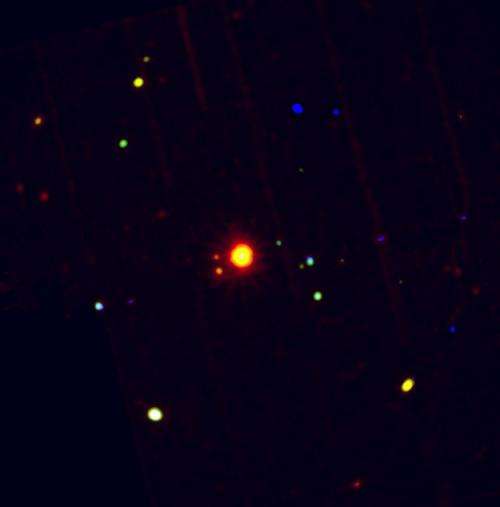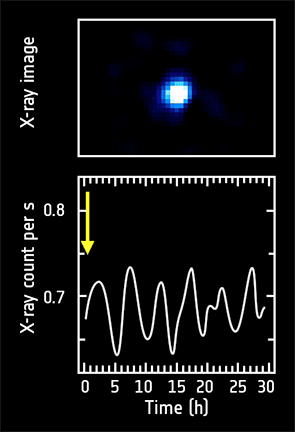Pulsating X-rays allow XMM-Newton to unmask a mysterious star

(Phys.org) —XMM-Newton has revealed a unique star. It is a celestial chimera with the body of a normal massive star yet the magnetic field of a dead, stellar dwarf. This makes it a singular object among the billions of known stars.
The race is now on to understand why it behaves in this way because the work hints at an unanticipated link between the deep interior of a star and the surrounding atmosphere.
The star is known only by its catalogue designation, Xi1 Canis Majoris. It lies some 1400 light years away yet it can be seen with the naked eye in the constellation Canis Major. This is because it is an extremely bright star with a surface temperature of approximately 27 500 K, and a mass of approximately 15 times that of the Sun.
This massive star draws particular attention to itself because it has an immensely strong magnetic field, nearly 10 000 times stronger than Earth's and 5000 times stronger than the Sun's. "Its magnetic field is outstandingly strong compared to other massive stars," says Lidia Oskinova, University of Potsdam, Germany, who led this latest study.
The star's magnetic field is carried into space by the stellar wind – a river of particles flowing outward from the star.
The star is a prime target for ESA's XMM-Newton X-ray observatory because it shines brightly in X-rays. These are thought to be coming from shock waves in the star's magnetic field that accelerate the stellar wind particles as despite the star's fearsome temperature, it is not hot enough to emit the amount of X-rays seen.

Together with colleagues from five different institutions on both sides of the Atlantic, Oskinova used XMM-Newton to observe Xi1 Canis Majoris to search for clues about the process.
XMM-Newton brought the star into focus for a preliminary, two-hour observation in October 2009, and then again for 29 hours of continuous observation in October 2012. It collected data simultaneously with its onboard RGS spectrograph and EPIC camera.
Analysing the longer observation, the team immediately discovered something unexpected. The star's X-ray emission pulsated, rising and falling in a regular, repeating fashion every 5 hours. Such pulsations have never before been seen from normal stars.
"So far, we don't understand the physics behind these pulsations," says Oskinova, referring to Xi1 Canis Majoris.
The only stars previously known to give off pulsating X-rays were stellar corpses known as degenerate stars. These are stars in which nuclear fusion has come to an end. As a result, they no longer generate energy and so collapse into extremely dense objects called white dwarfs or neutron stars.
A white dwarf is about the size of the Earth, whereas a neutron star is approximately 10 kilometres across. Neutron stars sweep beams of X-ray emission through space like a lighthouse, creating the pulsations, while white dwarfs vibrate extremely quickly, creating their X-ray pulses. Neither mechanism can work for normal stars, as both rely on the star being composed of highly compacted material, known as degenerate matter.
A clue may come from the fact that Xi1 Canis Majoris pulsates in optical light as well. This optical variability has been known for a century. The pulses are extremely stable, changing by less than a second in that time. They are driven by changes in the way radiation is absorbed and re-emitted inside the star- a process known as the kappa mechanism.
Between 1989 and 1993, the ESA mission Hipparcos monitored the star. Accessing the archive, the team compared these observations with the X-ray variations and found that they pulsated in unison. Oskinova thinks this is too big a coincidence to be chance.
"For me personally, this work has shown that stellar winds and the high energy radiation that comes from them must be linked by some physical mechanism to what is happening inside the star," says Oskinova.
The way forward, she says, is to develop better computer models of stellar interiors and use them to look for the way variable behaviour inside the star affects the stellar wind and magnetic field outside the star.
"This is breakthrough science because it shows that X-ray pulsations can take place not only in exotic objects but in normal stars too. New physical processes governing stellar winds can now be studied. Also, it highlights both the capabilities of XMM-Newton and the long lasting legacy of the Hipparcos star mapper," says Norbert Schartel, ESA XMM-Newton Project Scientist.
More information: "Discovery of X-ray pulsations from a massive star." Lidia M. Oskinova, et al. Nature Communications 5, Article number: 4024 DOI: 10.1038/ncomms5024. Received 26 January 2014 Accepted 01 May 2014 Published 03 June 2014
Journal information: Nature Communications
Provided by European Space Agency




















